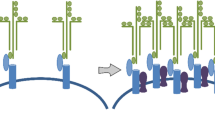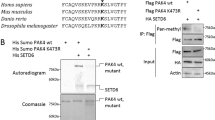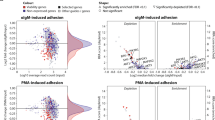Abstract
Altered cell adhesion is causally involved in tumor progression, and the identification of novel adhesion molecules altered in tumors is crucial for our understanding of tumor biology and for the development of new prognostic and therapeutic strategies. Here, we provide evidence for the epigenetic downregulation in breast tumors of the A Desintegrin And Metalloprotease domain 23 gene (ADAM 23), a member of a new family of surface molecules with roles in cell–cell adhesion and/or cell–matrix interactions. We examined the mRNA expression and methylation status of the 5′ upstream region of the ADAM23 gene in different breast tumor cell lines as well as in primary breast tumors. We found ADAM23 5′ hypermethylation in eight out of 12 (66.7%) tumor cell lines and in nine out of 13 (69.2%) primary tumors. Promoter hypermethylation was strongly associated with reductions in both mRNA and protein expression, with a threshold of 40–60% of modified CpG dinucleotides being required for the complete silencing of ADAM23 mRNA expression. Treatment of MCF-7 and SKBR-3 cell lines with 5′-Aza-2′-deoxycytidine led to a reactivation of ADAM23 mRNA expression and a marked decrease in the methylation level. It is worth noting that primary breast tumors with a more advanced grade showed a higher degree of methylation, suggesting that the adhesion molecule ADAM23 may be downregulated during the progression of breast cancer.
This is a preview of subscription content, access via your institution
Access options
Subscribe to this journal
Receive 50 print issues and online access
$259.00 per year
only $5.18 per issue
Buy this article
- Purchase on Springer Link
- Instant access to full article PDF
Prices may be subject to local taxes which are calculated during checkout






Similar content being viewed by others
Abbreviations
- ADAM:
-
A Desintegrin And Metalloprotease domain
- MDC:
-
Metalloprotease/Disintegrin/Cysteine rich
- TACE:
-
TNF-α converting enzyme
- TNF-α:
-
tumor necrosis factor-α
- CAM:
-
cell adhesion molecule
- 5′-Aza-dCR:
-
5′-Aza-2′-deoxycytidine
References
Black RA and White JM . (1998). Curr. Opin. Cell Biol., 10, 654–659.
Cal S, Freije JM, Lopez JM, Takada Y and Lopez-Otin C . (2000). Mol. Cell. Biol., 11, 1457–1469.
Cameron EE, Baylin SB and Herman JG . (1999). Blood, 94, 2445–2451.
Cavallaro U and Christofori G . (2001). Biochim. Biophys. Acta, 1552, 39–45.
Church GM and Gilbert W . (1984). Proc. Natl. Acad. Sci. USA, 81, 1991–1995.
Clark SJ and Melki J . (2002). Oncogene, 21, 5380–5387.
Cousin H, Gaultier A, Bleux C, Darribere T and Alfandari D . (2000). Dev. Biol., 227, 197–210.
Curradi M, Izzo A, Badaracco G and Landsberger N. . (2002). Mol. Cell. Biol., 22, 3157–3173.
Ehrlich M . (2002). Oncogene, 21, 5400–5413.
Emi M, Katagiri T, Harada Y, Saito H, Inazawa J, Ito I, Kasumi F and Nakamura Y . (1993). Nat. Genet., 5, 151–157.
Esteller M . (2002). Oncogene, 21, 5427–5440.
Garinis GA, Patrinos GP, Spanakis NE and Menounos PG. . (2002). Hum. Genet., 111, 115–127.
Graff JR, Gabrielson E, Fujii H, Baylin SB and Herman JG . (2000). J. Biol. Chem., 275, 2727–2732.
Herren B, Garton KJ, Coats S, Bowen-Pope DF, Ross R and Raines EW . (2001). Exp. Cell Res., 271, 152–160.
Howard L, Nelson KK, Maciewicz RA and Blobel CP . (1999). J. Biol. Chem., 274, 31693–31699.
Hsieh CL . (1994). Mol. Cell. Biol., 14, 5487–5494.
Jemal A, Murray T, Samuels A, Ghafoor A, Ward E and Thun MJ . (2003). CA Cancer J. Clin., 53, 5–26.
Jones PA and Baylin SB . (2002). Nat. Rev. Genet., 3, 415–428.
Jones PA and Laird PW . (1999). Nat. Genet., 21, 163–167.
McCulloch DR, Harvey M and Herington AC . (2000). Mol. Cell Endocrinol., 167, 11–21.
Moss ML, White JM, Lambert MH and Andrews RC . (2001). Drug. Discov. Today, 6, 417–426.
Ohtani-Fujita N, Fujita T, Aoike A, Osifchin NE, Robbins PD and Sakai T . (1993). Oncogene, 8, 1063–1067.
Okegawa T, Li Y, Pong RC and Hsieh JT . (2002). J. Urol., 167, 1836–1843.
Primakoff P and Myles DG . (2000). Trends Genet., 16, 83–87.
Radice D and Redaelli A . (2003). Pharmacogenomics, 21, 383–396.
Robertson KD . (2002). Oncogene, 21, 5361–5379.
Sagane K, Ohya Y, Hasegawa Y and Tanaka I . (1998). Biochem. J., 334, 93–98.
Scanlan MJ, Gordon CM, Williamson B, Lee SY, Chen YT, Stockert E, Jungbluth A, Ritter G, Jager D, Jager E, Knuth A and Old LJ . (2002). Int. J. Cancer, 98, 485–492.
Suzuki A, Kadota N, Hara T, Nakagami Y, Izumi T, Takenawa T, Sabe H and Endo T . (2000). Oncogene, 19, 5842–5850.
Towbin H, Staehelin T and Gordon J . (1979). Proc. Natl. Acad. Sci. USA, 76, 350–4354.
Turker MS . (2002). Oncogene, 21, 5388–5393.
Welch DR, Steeg PS and Rinker-Schaeffer CW . (2000). Breast Cancer Res., 2, 408–416.
Weskamp G, Kratzschmar J, Reid MS and Blobel CP . (1996). J. Cell Biol., 132, 717–726.
Wolfsberg TG, Primakoff P, Myles DG and White JM . (1995a). J. Cell Biol., 131, 275–278.
Wolfsberg TG, Straight PD, Gerena RL, Huovila AP, Primakoff P, Myles DG and White JM . (1995b). Dev. Biol., 169, 378–383.
Wu E, Croucher PI and McKie N . (1997). Biochem. Biophys. Res. Commun., 235, 437–442.
Acknowledgements
We thank Dr Ricardo R Brentani, Dr Roger Chamas, Dr Luís F Reis, Dr Dirce M Carraro and Dr Eduardo F Abrantes for critically reading this manuscript and Valéria Paixão, Marilene H Lopes and Waleska K Martins for technical assistance. This work was supported by The Ludwig Institute for Cancer Research (LICR) – São Paulo – Brazil and by the CEPID Program from the Fundação de Amparo a Pesquisa do Estado de São Paulo (FAPESP). FFC is sponsored by a fellowship from FAPESP.
Author information
Authors and Affiliations
Corresponding author
Rights and permissions
About this article
Cite this article
Costa, F., Verbisck, N., Salim, A. et al. Epigenetic silencing of the adhesion molecule ADAM23 is highly frequent in breast tumors. Oncogene 23, 1481–1488 (2004). https://doi.org/10.1038/sj.onc.1207263
Received:
Accepted:
Published:
Issue Date:
DOI: https://doi.org/10.1038/sj.onc.1207263
Keywords
This article is cited by
-
The rexinoid V-125 reduces tumor growth in preclinical models of breast and lung cancer
Scientific Reports (2022)
-
Decreased methylation in the SNAI2 and ADAM23 genes associated with de-differentiation and haematogenous dissemination in breast cancers
BMC Cancer (2018)
-
Down regulation of ADAM33 as a Predictive Biomarker of Aggressive Breast Cancer
Scientific Reports (2017)
-
ADAM33 gene silencing by promoter hypermethylation as a molecular marker in breast invasive lobular carcinoma
BMC Cancer (2009)
-
Gene expression signatures and biomarkers of noninvasive and invasive breast cancer cells: comprehensive profiles by representational difference analysis, microarrays and proteomics
Oncogene (2006)



